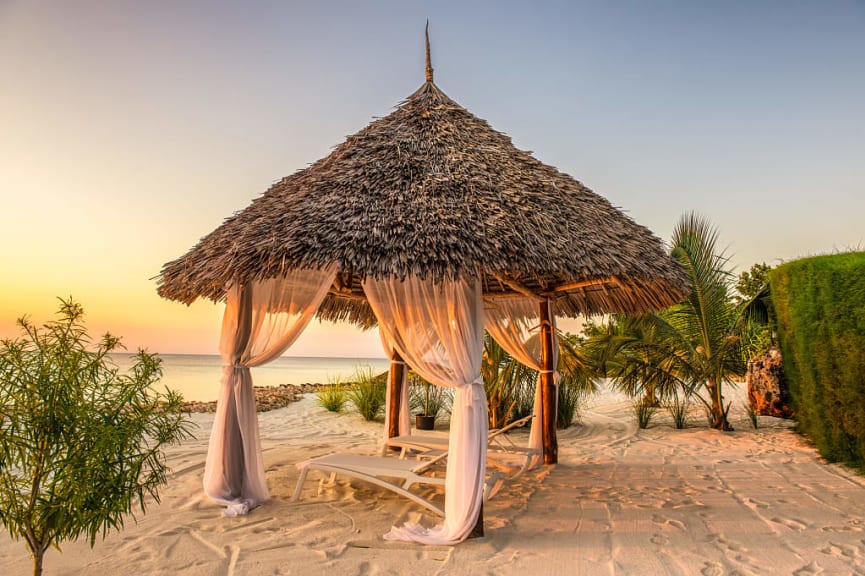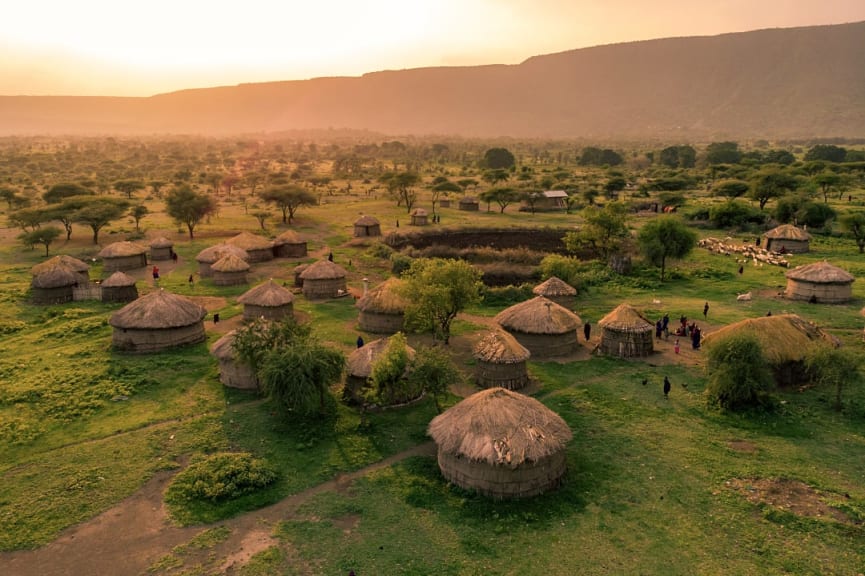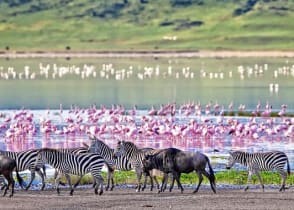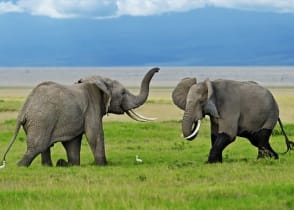Best Time to Visit Tanzania

Lion in Eastern Serengeti, Tanzania
The best time to visit Tanzania is from the end of May to the end of October, just before the short rains begin.
As the second-largest country in East Africa, the idyllic setting between the western mountains and eastern Indian Ocean coastline is perfectly suited for majestic wildlife and breathtaking beach escapes.
While Tanzania is pleasant year-round, knowing you can have completely different experiences at different times of the year, and considering your personal safari needs, it is good to know how things differ so you can plan accordingly.
Best Time to Visit by Season

Cheetahs in the Serengeti
The Tanzania safari circuit buzzes year-round. However there are definite high, low, and shoulder seasons throughout.
While summer, spring, winter, and fall partially describe the shifting weather patterns, the country is more typically divided into two seasons, dry and wet, or the “green” season.
The Tanzanian weather patterns play a big part in how they are divided, and availability and pricing may reflect this. Below is an idea of how the safari season is broken down.
High Season: June • July • August • September • October
The rains have stopped, the grass is low, and there is a slight chill in the air, meaning winter is coming to the country; the dry, cool conditions making it the most ideal time to go on safari.
Days are mild, with animals seeking water and warmth, and sightings increasing in popular parks and reserves. High season also means competitive pricing and large crowds, so it’s best to be aware of this and book far in advance.
Game drives start early in the morning, brisk temperatures requiring hot-water bottles and blankets as the open-air theater awakens. In the afternoon, witness incredible sunsets, the clear skies turning oranges and yellows as day turns to night.
A highlight of the high season has to be the Great Migration, a spectacular show that usually takes place in July and October when wildebeest travel between Kenya and Tanzania in a crossing of thunderous drama.
Shoulder Season: November • December • January • February
Short rains fall from the beginning of November, continuing into December, bringing a sense of freshness to the surroundings. The weather starts to warm up considerably and wildlife begins to retreat in search of shade.
The little rain that does fall clears the dust and helps to fill small waterholes around the reserves. By the end of December the rain starts to fall a little harder and with the peak of summer just around the corner, lodges and camps seem quieter.
Bird life is prolific in January, with the wildlife birthing season in February, a time when the bush comes alive with new life and sightings become challenging but exciting.
Low Season: March • April • May
By March the rains are falling hard, soaking the dry savannah.
Game viewing can be challenging during this time as the grass stands tall and shrubbery is thick. Wet conditions mean animals have plenty of access to water and don’t have to venture out to waterholes, for example.
Many lodges and safari camps use this time to do refurbishments in preparation for the high season. For those visitors wanting to travel at the beginning or end of the low season, availability is fantastic and can be reflected in pricing.
Best Time for Game Drives

Game drive in Eastern Serengeti, Tanzania
Best Months: June • July • August • September • October
A game drive in Tanzania is essential, especially when visiting during the dry season between July and October.
The height you have from an elevated vehicle, in addition to the shorter, more parched grasses, make it much easier to see wildlife, whether you are looking for lions basking in the sun or dik-dik hiding in the bush.
The Southern Hemisphere’s winter months are comfortable, the mild weather inviting wildlife to congregate around water sources like lakes, rivers, and ponds. The crisp early mornings and dramatic sunsets also set the scene for breathtaking coffee and sundowner breaks in carefully selected spots, always a highlight of a game drive.
Best Time for the Great Migration Crossing

Wildebeests crossing river during the great migration in Tanzania
Best Months: June • July • August • October • November
The best time to witness the wildebeest migration is the end of June into early July and again between October and November.
The migration is constant, with certain months prime crossing and viewing times. In June and July, the scene is set to witness hundreds of wildebeests crossing the Mara River in northern Serengeti as they move from Tanzania to Kenya’s Maasai Mara. From the end of October through December, the herds cross back into eastern Serengeti, just ahead of the long rains.
Being in Tanzania for Tanzania Great Migration Safaris is an unforgettable experience that reveals the indelible circle of life. While it doesn’t follow a predictable route, the wildebeest, zebra, and antelope travel along similar paths across vast plains, making every migration equally exciting.
Best Time for Walking Safaris

Giraffes in Serengeti National Park, Tanzania
Best Months: July • August • September • October
The best time for a walking safari in Tanzania is during the dry months of the Southern Hemisphere’s winter, July to October.
Discover nature and watch animals from a safe distance as your guide leads you through savannahs and along dried river beds. Walking areas may differ depending on the national park or reserve you are in, the short grass and waterholes making it much easier to find wildlife.
A walking safari is an intimate adventure that gives you deeper insight into the African bush, from spoor spotting to witnessing the daily tribulations of insects and admiring the variety of flora and fauna.
Best Time for Birding Safaris

Crowned Crane
Best Months: December • January • February
Tanzania is home to an impressive number of bird species and the best time to visit for them would be from the end of December, through January and February.
Watch from the comfort of your open vehicle or through the pop-up roof of your 4x4 safari vehicle as the bush displays a colorful array of winged beauties. Listen to calls that never seem to end and take in their fascinating habits and traits.
Walking safaris are possible usually early in the day to avoid the summer heat or short rains that may fall, with the opportunity to get up close and personal to some of the most exquisite birds in Africa.
Best Time for Mobile Safaris

Photo courtesy of Lemala Ndutu Tented Camp in the Southern Serengeti
Best Months: June • July • August • September • October
Reduce your carbon footprint by embarking on a mobile safari during your visit to Tanzania from June to October. Camps are set up in strategic locations and are taken down once the mobile safari season is done.
The dry weather makes setting up camp easier for your safari providers and the clear nights mean it’s easier for those on watch to keep any would-be visitors at bay. Game viewing can be enjoyed in open vehicles, closed 4x4s with pop-up roofs, or on foot as qualified guides share their love of the bush.
Moving from reserve to game park offers you a diverse safari experience, with accommodation options ranging from fly camps to luxury tented or treehouse adventures.
Best Time for a Family Safari

Serengeti, Tanzania
Best Months: June • July • August • September
A safari is one of the best experiences you can have as a family and Tanzania makes it easy, especially during the dry season from June to September.
Wildlife viewing is not just about seeing the animals, but about the thrill of spotting lions, giraffes, or even chimpanzees. The dry season makes it much easier to find wildlife that will keep your family members engaged no matter their ages.
For some downtime and water adventures post-safari, consider a few nights in Zanzibar at one of many family-friendly resorts. You can explore our Tanzania Family Safaris for ideas on how to spend your stay.
Best Time for a Safari for Seniors

Wildebeests at Ngorongoro Crater, Tanzania
Best Months: May • June • July • September • October
The best time for a safari for seniors in Tanzania is at the end of the fall month of May, through the summer months of June and July, and again in September and October. The weather is mild during the day, with cozy facilities in the lodges and camps at night.
Game viewing is optimal during these months and traveling between game parks and safari reserves is in comfortable, enclosed 4x4s. Avoiding the high season of August will make the overall experience most memorable as enjoy the full attention of your experienced guide.
September and October should also be considered as there is the opportunity to witness the great migration in October. At the outer edge of the month, you can find a quieter safari circuit, allowing senior safari-goers to embark on an adventure without the bustle of tourists and the frenzy of safari vehicles on Tanzania Safaris for Seniors.
Best Time for a Romantic Safari for Couples

Zanzibar
Best Months: June • July • August • September
The best time to visit Tanzania for a couple’s safari is during the dry season, from the end of May to late September, with October providing a more quiet experience once the winter crowds have gone.
With plenty of opportunities to see the Big Five, predators, and the Great Migration, your once-in-a-lifetime romantic getaway or honeymoon will feel like a perfect experience. It is not just about the game drives or wildlife excursions, but also charming accommodations that can place you in luxury and seclusion, with views spanning an endless savanna or overlooking a waterhole.
Your private getaway can take you from the bush to a secluded island setting when you combine your safari with some beach time in Zanzibar. Here, candle-lit dinners on the water are only a part of the experience. For more romantic safari ideas, explore our Tanzania Honeymoon Packages.
Best Time for a Zanzibar Beach Escape

Stonetown, Zanzibar
Best Months: June • July • August • September • October • November • January
The best time to visit Zanzibar for a beach escape is after your safari, usually from June to the end of November. A short, dry period exists in January and while the summer sun will keep things warm, humidity is high.
Located on the east coast of Africa, the Zanzibar archipelago offers cultural intrigue and breathtaking beaches. Influenced by Arab and Indian culture, this African gem is definitely worth adding to any Tanzania safari itinerary.
Visit historic Stonetown, a colorful city that was once a key trading center, a bustling market and art seemingly on every doorstep. Admire the famous Zanzibar doors and other historical architecture. Discover why the archipelago is known as the Spice Islands and spend days on white-sand beaches at one of the many resorts.
Best Time for Cultural Adventures

Maasai village in Arusha, Tanzania
Best Months: May • June • July • August • September • October • November • December
A cultural visit as an add-on to a northern or southern circuit safari can be experienced year-round, with visits to Maasai villages, Tanzanian homesteads, and rural settlements.
Understand the rich history of the Swahili language, the cultural traditions of the Maasai and Hadzabe, and enjoy local cuisine while listening to stories of ancestors.
Discover the importance of the spice trade and how this once-rich commodity shaped Stonetown and beyond.
Tanzania Safari Activities by Season

Pride of lions in Eastern Serengeti, Tanzania
Tanzania is positioned in the Southern Hemisphere, which flips the season of the year. For reference, that means winter is between June and August, spring takes place between September and November, summer is from December to February, and March to May is fall.
Animal movements and sightings will shift with the seasons, having an impact on certain activities. Cultural experiences can be enjoyed throughout the year and an island getaway will be the ideal way to end your safari.
Best Time for Spring & Summer Activities

Great migration in East Serengeti, Tanzania
Best Months: October • November • December
The beginning of spring sees safari parks and reserves buzzing with wildlife moving to waterholes and gathering in savannas as the days start to warm up. October brings the Great Migration of wildebeest back to the Serengeti in Tanzania from the Maasai Mara in Kenya, with some action still happening in November.
The short rains start as spring turns to summer and December showers bring relief to the dry plains and cities. September to December are the optimal times to enjoy the beaches of Zanzibar, with February and early March also lovely months in which to experience an island escape.
Prime birding season and the start of the birthing season take place in January and February, just before the long rains, and the warm summer days are filled with the sounds of the bush.
Activities: Game drives • Bird-watching safaris • Cultural experiences • Beach escapes in Zanzibar • Migration safaris
Best Time for Fall & Winter Activities

Arusha Game Reserve, Tanzania
Best Months: April • May • June
As the long rains set in from March to early May, the safari circuit tends to quieten down as animals take shelter and water is readily accessible in parks and reserves. As June brings with it cooler days and winter starts to creep in, the bush comes alive and the safari season truly begins.
July presents a theatrical moment like no other as the Great Migration takes place, with herds of wildebeest thundering across the Mara River from the Serengeti in Tanzania to the Maasai Mara in Kenya.
August is peak season and an ideal time for walking safaris and activities such as hot-air balloon rides. Even though the air is a little cooler, adding on some time in Zanzibar for cultural and historic experiences, plus a few days on the beach, is quite popular.
Activities: Migration safaris • Safari walks • Game drives • Boating excursions • Hot-air balloon experiences • Cultural visits • Beach escapes in Zanzibar
Book for the Best Time for Your Tanzania Safari

Hot air balloon over the Serengeti in Tanzania
Tanzania is a safari destination unlike any other, with a diverse circuit comprising dramatic game parks and reserves, and a wildlife complement that outshines other destinations. Famous parks like the Serengeti and Ngorongoro Crater are only upstaged by the dramatic Great Migration and stunning white-sand beaches add tranquility to a fascinating destination.
The best time to visit Tanzania will be determined by who is traveling, what is expected during your time in the country, and how you wish to experience it all. For ideas on what to do in Tanzania, take a look at our Tanzania Safari Tours & Vacations and our Tanzania Safari Guide.
Life-Enriching Travel Designed Just for You
- 1
Trips curated by the world’s top destination experts
- 2
Concierge-level service leading up to and during your trip
- 3
Unique, exclusive experiences and insider access





